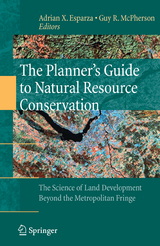The Planner’s Guide to Natural Resource Conservation:
Springer-Verlag New York Inc.
978-0-387-98166-6 (ISBN)
Our philosophy is reflected in the book’s two objectives. First, we seek to document the extent and impacts of exurban development across the country. At issue is demonstrating why planners and the public-at-large should be concerned about exurbanization. We will demonstrate that even though exurbanization favors amenity rich regions, it affects all areas of the country through the loss of agricultural and grazing lands, impacts to watersheds and land modification. A summary of environmental impacts is presented, including the loss of wildlands and agricultural productivity, land modification, soil erosion, impacts to terrestrial hydrologic systems, the loss of biodiversity, nonnative and endangered species and other topics.
Our second aim is to provide readers from diverse (nonscientific) backgrounds with a working knowledge of how and why exurbanization impacts environmental systems. This is accomplished by working closely to ensure contributors follow a specific outline for each chapter. First, contributors will spell out fundamental concepts, principles and processes that applyto their area of expertise (e.g., riparian areas). Contributors will move beyond a cursory understanding of ecological processes without overwhelming readers with the dense material found typically in specialized texts. For this reason, visuals and other support materials will be integral to each chapter. We have chosen contributors carefully based on their record as research scientists and acumen as educators. Second, once the mechanics have been laid out, authors will explain how and why land development in nearby areas influences ecosystems. Issues of interdependency, modification and adaptation, spatial scale and varying time horizons will be featured. Third, contributors will weigh in on the pros and cons of various land-development schemes. Fourth, authors will share their thinking on the merits of conservation devices such as wildlife corridors, open-space requirements and watershed management districts. Finally, each chapter will conclude by identifying pitfalls to avoid and highlighting "best practices" that will mitigate environmental problems or avoid them altogether. In sum, after completing each chapter, readers should have a firm grasp of relevant concepts and processes, an understanding of current research and know how to apply science to land-use decisions.
Adrian X. Esparza is Associate Professor in the School of Natural Resources at the University of Arizona (Ph.D. 1987, University of Illinois-Urbana). He taught previously in the School of Planning, College of Architecture at the University of Arizona. His research focuses on exurban land development in the southwest United States and urbanization in the United States-Mexico border region. He has published dozens of articles in the fields of urban and regional planning and regional science. Guy McPherson is a Professor in the School of Natural Resources at the University of Arizona (Ph.D. 1987, Texas Tech University). He also worked for the University of Georgia, Texas A & M University, University of California-Berkeley, and The Nature Conservancy. His research focuses on development and application of ecological knowledge. His scholarly efforts have produced dozens of journal articles and eight books.
SECTION 1: HISTORY AND FUNDAMENTAL ECOLOGICAL CONCEPTS.- Exurbanization and Aldo Leopold’s Human–Land Community.- Fundamental Concepts in Ecology.- Climate Change and Ecology in Rural Lands.- SECTION 2: EXURBAN LAND DEVELOPMENT, HABITAT AND WILDLIFE.- Biodiversity and Residential Development Beyond the Urban Fringe.- Wildlife Corridors and Developed Landscapes.- Exurban Land Development and Breeding Birds.- Integrating Wildlife Conservation into Land-Use Plans for Rapidly Growing Cities.- Into the Wild: Vegetation, Alien Plants, and Familiar Fire at the Exurban Frontier.- SECTION 3: WATER RESOURCES, WETLANDS AND STORM WATER MANAGEMENT.- Impacts of Exurban Development on Water Quality.- Preparing for Human Expansion into Exurban Riparian Areas.- Storm Water Management in Exurbia.- SECTION 4: SCIENCE-BASED PLANNING IN EXURBAN AREAS.- A Science-Based Approach to Regional Conservation Planning.- Mitigating Environmental Problems in Exurban Development: An Overview of Rural-Specific Planning Devices.
From the reviews:
“Editors Esparza and McPherson (both, Univ. of Arizona) have divided this 13-chapter work into four parts. … Each part offers a useful starting point for those interested in the intersection of exurban planning and environmental problems. … Summing Up: Recommended. … Upper-division undergraduates through professionals/practitioners.” (B. D. Orr, Choice, Vol. 47 (5), January, 2010)
| Erscheint lt. Verlag | 6.7.2009 |
|---|---|
| Zusatzinfo | XXII, 258 p. |
| Verlagsort | New York, NY |
| Sprache | englisch |
| Maße | 155 x 235 mm |
| Themenwelt | Naturwissenschaften ► Biologie ► Ökologie / Naturschutz |
| ISBN-10 | 0-387-98166-7 / 0387981667 |
| ISBN-13 | 978-0-387-98166-6 / 9780387981666 |
| Zustand | Neuware |
| Haben Sie eine Frage zum Produkt? |
aus dem Bereich




